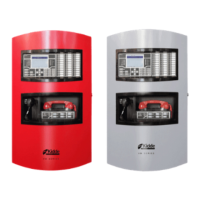
Do you have a question about the Kidde VM-1 and is the answer not in the manual?
| Battery Backup | 9V Battery |
|---|---|
| Sensor Type | Photoelectric |
| Alarm Sound Level | 85 dB at 10 feet |
| Voltage Range | 120V AC |
| Operating Temperature | 40°F to 100°F (4°C to 38°C) |
Outlines the extent of Walter Kidde Portable Equipment, Inc.'s liability for damages.
Explains the meaning and use of Warning, Caution, and Note messages.
Describes the VM-1 control panel's function, interface, and network capabilities.
Details the VM-1 control panel's basic and expandable hardware configurations.
Explains the physical controls, buttons, LEDs, and display on the VM-1 panel.
Explains how the VM-1 panel monitors status changes and generates events.
Details how event messages are stored, displayed, and managed in queues.
Outlines different operator access levels and their associated privileges.
Provides instructions for making announcements via the VM-PMI paging microphone.
Instructions for using the VM-MFK firefighters telephone for communication.
Describes the function and use of VM-1 remote annunciators.
Explains how system events are transmitted via email and text messages.
How to view system status reports to identify active points.
Locating detectors requiring maintenance based on %Dirty values.
Procedures for accessing logged events and operator instructions.
How to view system software and database versions.
How to check the number of times the panel has entered alarm.
How to find the panel's IP address, subnet mask, and gateway settings.
How to check VM-DACT compliance with NFPA 72 requirements.
Instructions on how to silence the panel's audible buzzer.
Procedures for silencing audible and visible alarm signals.
How to confirm that an event message has been seen.
Steps to restore the fire alarm system to its normal state.
How to test all LEDs and the LCD display on the panel.
How to trigger alarm signals for testing without a full alarm state.
How to toggle the LCD screen text to a secondary language.
How to activate alternate alarm sensitivity settings for detectors.
How to activate alternate message routing for event messages.
Procedures for temporarily preventing devices from functioning.
How to disable or enable entire groups of devices.
Instructions for adjusting the panel's system clock and date.
How to download the project database to the panel via TCP/IP.
How to retrieve status and diagnostic information from the panel via TCP/IP.
How to test V-Series CO detectors using accelerated response mode.
Overview of periodic visual inspections and maintenance testing requirements.
Section for documenting contact information for service providers.
Schedule and procedures for visual inspections of system components.
Schedule for performing routine maintenance on the VM-1 life safety system.
Guidance on diagnosing and resolving common system problems.
Explanation of the PPCCDDDD format for VM-1 addresses.
Details on physical and logical addresses for VM-1 system cards.
Lists device addresses for points on the VM-1 hardware layer.
Lists device addresses for points on the VM-1 operator layer.
Device addresses for LEDs and switches on remote annunciators.